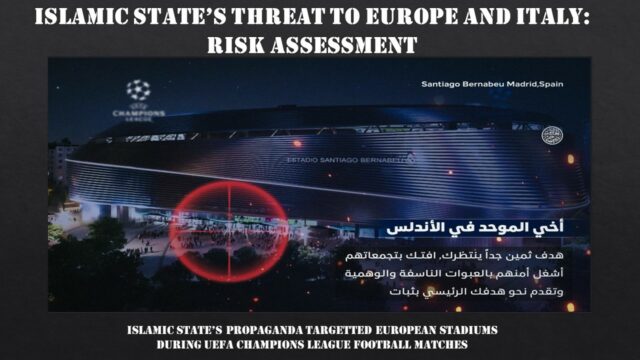Islamic State’s Threat to Europe and Italy: Risk Assessment

Geopolitical Report ISSN 2785-2598 Volume 41 Issue 21
Author: Christian Tratzi
Executive Summary
The resurgence of the Islamic State poses a significant threat to Italy and Europe, leveraging geopolitical events to bolster propaganda and recruitment efforts. The evolving landscape of terrorism, characterised by decentralised online radicalisation, presents challenges in surveillance and counteraction.
Additionally, the nexus between migration and radicalisation underscores the complexities of border control and security measures. Africa, particularly the Central African and Sahel regions, emerges as a focal point because of the proliferation of Islamic State activity and the potential for destabilisation. Italy remains vulnerable as a primary entry point for migratory flows from Africa, necessitating proactive measures to address security concerns.
Geopolitical Scenario
The resurgence of the Islamic State (IS) within the current geopolitical landscape presents a multifaceted challenge for Italy and Europe. Despite efforts to dismantle its organisational structure, IS has adapted to geopolitical shifts, leveraging regional conflicts and socio-political unrest to reinvigorate its propaganda machinery.
The conflict in Palestine, exacerbated by the enduring Israeli-Palestinian tensions, has provided fertile ground for IS to reassert its presence and amplify its messaging.
The situation in Gaza, characterised by civilian casualties and humanitarian crises, serves as a rallying point for extremist ideologies, fuelling resentment and susceptibility to radicalisation among vulnerable populations in Europe.
The war in Ukraine has reverberated across continents, serving as a catalyst for global jihadist movements. While people may perceive the primary focus of IS activity as distant, Europe keenly feels the repercussions. The escalation of violence in Ukraine has exacerbated tensions between Russia and Western powers, creating a climate of uncertainty and instability conducive to extremist recruitment efforts.
Additionally, the proliferation of conflict zones globally provides IS with ample opportunities to exploit grievances and recruit individuals disillusioned with prevailing geopolitical realities.
The emergence of decentralised online radicalisation poses significant challenges to traditional counterterrorism strategies. The evolution of IS propaganda from localised dissemination to global reach via the internet has transformed the threat landscape.
Online forums, social media platforms, and gaming communities serve as breeding grounds for extremist ideologies, facilitating recruitment and radicalisation on an unprecedented scale. The borderless nature of cyberspace presents difficulties in monitoring and regulating extremist content, allowing IS to exert influence beyond physical borders and directly target susceptible individuals in Europe.
The intersection of migration flows and radicalisation adds another layer of complexity to the geopolitical scenario. Europe, as a destination for migrants fleeing conflict and instability, faces the dual challenge of managing humanitarian crises while safeguarding against terrorist infiltration.
The nexus between migration and terrorism, though often politicised, underscores the need for comprehensive border control measures and intelligence-sharing mechanisms. As the primary entry point for migratory flows from Africa, Italy is particularly vulnerable to the convergence of geopolitical factors and extremist threats.
Read also | The Islamic State and the Israeli-Palestinian Conflict. Religious Propaganda and Global Call to Action |
Italy and Europe: A Risk Assessment
The developing tactics and strategies employed by the Islamic State present a dynamic and multifaceted risk landscape for Italy and Europe. The decentralisation of IS operations, coupled with the proliferation of online radicalisation, has transformed the threat from traditional hierarchical structures to dispersed and individualised actors.
Lone wolf attacks, characterised by low-cost and high-impact methodologies, pose a significant challenge to law enforcement agencies and intelligence services. The increasing prevalence of self-radicalised individuals, particularly among younger demographics, underscores the need for proactive measures to disrupt recruitment networks and prevent extremist violence.
The resurgence of IS activity in Africa, particularly in the Central African and Sahel regions, presents a potent threat to European security. The potential for Africa to serve as a launchpad for terrorist activities targeting Europe, facilitated by porous borders and weak governance structures, amplifies the risk of transnational extremism.
The proliferation of illicit trafficking networks, including human trafficking and drug smuggling, provides IS with a lucrative revenue stream and operational foothold in the region. Understanding the interplay between terrorism and organised crime emphasises the multifaceted challenge we face, demanding synchronised measures to resolve deep-seated socio-economic and political issues.
Additionally, the convergence of migration flows and radicalisation underscores the vulnerabilities inherent in Europe’s border security apparatus. The influx of migrants from conflict zones, coupled with the exploitation of humanitarian crises by extremist groups, poses challenges in identifying and mitigating potential security threats.
The relationship between migration dynamics and terrorist infiltration requires comprehensive border control measures and intelligence-sharing mechanisms to effectively address security concerns. Enhanced cooperation between European nations and regional partners is essential to develop robust counterterrorism strategies and prevent the exploitation of migration routes by extremist elements.
Conclusion/Recommendations
To address the growing threat landscape, proactive measures are imperative. Strengthening border security and intelligence-sharing mechanisms is crucial to mitigate the risks associated with migration and terrorist infiltration.
Enhanced surveillance of online platforms and gaming communities, coupled with targeted counter-narrative campaigns, can help disrupt radicalisation efforts and prevent lone wolf attacks.
Bolstering partnerships with African nations to address instability in the Sahel region is essential to prevent the proliferation of Islamic State activity and mitigate its impact on European security.
In conclusion, a multi-faceted approach encompassing border security, intelligence collaboration, and counter-radicalisation efforts is paramount to effectively combatting the threat posed by the Islamic State and safeguarding the security of Italy and Europe.
Read also | Teenagers’ Terrorist Cells Linked to the Islamic State Arrested in Germany and Switzerland |
For further reports, risk assessments, and analyses about the terrorist threat in Europe and Italy, contact us at info@specialeurasia.com.
